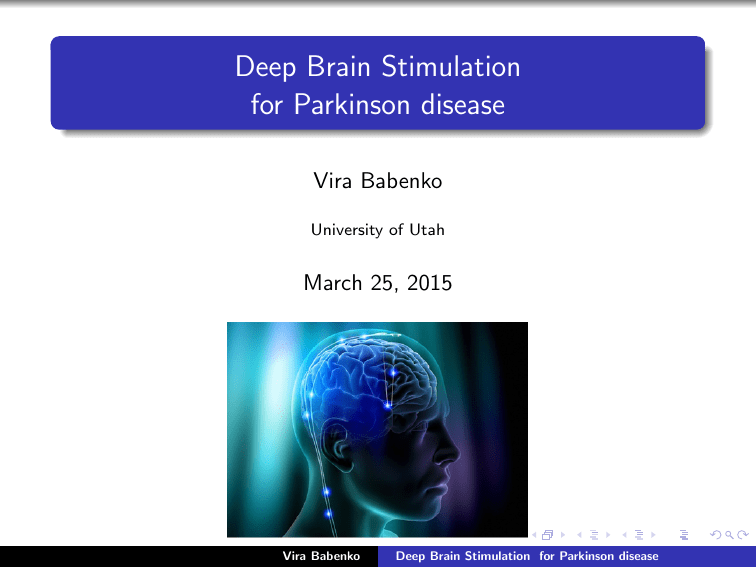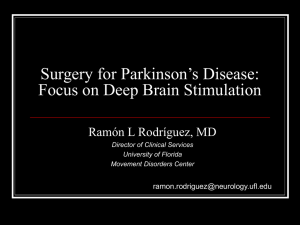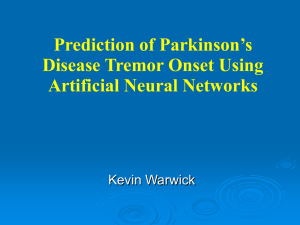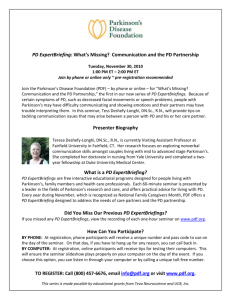Deep Brain Stimulation for Parkinson disease Vira Babenko March 25, 2015
advertisement

Deep Brain Stimulation for Parkinson disease Vira Babenko University of Utah March 25, 2015 Vira Babenko Deep Brain Stimulation for Parkinson disease Background Definition Parkinson’s disease is a chronic, degenerative neurological disorder that affects one in 100 people over age 60. While the average age at onset is 60, people have been diagnosed as young as 18. Disease has different symptoms, including violations such as tremor, slowness and difficulty of movement. Later, thinking and behavioral problems may arise as well. Vira Babenko Deep Brain Stimulation for Parkinson disease Background There is no objective test, or biomarker, for Parkinson’s disease, so the rate of misdiagnosis can be relatively high. Moreover, symptoms of Parkinsons will start to appear when between 60% and 80% of the nerve cells that are responsible for the progression of the disease have already been lost. Estimates of the number of people living with the disease therefore vary, but recent research indicates that at least 7 to 10 million people worldwide are living with Parkinson’s disease. Vira Babenko Deep Brain Stimulation for Parkinson disease History Parkinson’s disease was first characterized extensively by an English doctor, James Parkinson, in 1817. Now it’s considered that the motor symptoms of Parkinson’s disease result from the death of dopamine-generating cells in the substantia nigra, a region of the midbrain. Dopamine is chemical messenger responsible for transmitting signals within the brain that allow for coordination of movement. Vira Babenko Deep Brain Stimulation for Parkinson disease Loss of dopamine causes neurons to fire without normal control, leaving patients less able to direct or control their movement. The cause of this cell death is unknown. Medications: There is no cure for Parkinson’s disease, but medications can provide relief from the symptoms increase the level of dopamin in certain areas of the brain prevent its rapid destruction Today’s best drug was discovered in 1967! Disease is very progressive! And there is a variety of side effects includes dyskinesia. Vira Babenko Deep Brain Stimulation for Parkinson disease DBS Long time ago people noticed that patients with parkinson’s disease some time had partial suppressions of tremor in the case of destruction of certain parts of the brain, injure or stroke. Destructive brain surgeries were very common operations prior to the opening of effective drugs. Vira Babenko Deep Brain Stimulation for Parkinson disease History of DBS In 1970s scientists found that high-frequency stimulation of certain parts of the brain mimics their destruction, without causing any serious side effects. Now more than 50,000 peoples live with Deep Brain Stimulation implant. Vira Babenko Deep Brain Stimulation for Parkinson disease DBS=Deep Brain Stimulation is a surgical treatment involving the implantation of a medical device called a brain pacemaker wich sends electrical impulses to specific parts of the brain. Vira Babenko Deep Brain Stimulation for Parkinson disease DBS The deep brain stimulation system consists of three components: the implanted pulse generator (IPG), the lead, the extension. The IPG is a battery-powered neurostimulator encased in a titanium housing, which sends electrical pulses to the brain to interfere with neural activity at the target site. Vira Babenko Deep Brain Stimulation for Parkinson disease DBS All three components are surgically implanted inside the body. Lead implantation usually take place under local anesthesia. A hole about 14 mm in diameter is drilled in the skull and the probe electrode is inserted stereotactically. During the awake procedure with local anesthesia, feedback from the patient is used to determine optimal placement of the permanent electrode. Vira Babenko Deep Brain Stimulation for Parkinson disease DBS The stimulator is adjusted as necessary to optimize the effects of the surgery. Vira Babenko Deep Brain Stimulation for Parkinson disease DBS applied in: Parkinson’s disease (2002) Essential tremor (1997) Dystonia (sustained muscle contractions cause twisting and repetitive movements or abnormal postures) (2003) Tourette syndrome(characterized by multiple motor tics and at least one vocal tic) Chronic pain(defined as pain that has lasted longer than three to six months) Major depression Epilepsy Vira Babenko Deep Brain Stimulation for Parkinson disease Questions: Why does it work? What kind of signals should we send? Where to place electrodes? How many electrodes should be placed? How to prolong the battery life? Vira Babenko Deep Brain Stimulation for Parkinson disease DBS may help patients achieve motor function off of medication that is similar to their best pre-operative motor function while on medication, although this is not always the case. DBS also reduces motor fluctuations and off-time. While DBS can produce major improvements in many aspects of Parkinsons disease, this is not always the case. It is important to approach DBS with realistic expectations and an acceptance of the risks and benefits associated with surgery. Vira Babenko Deep Brain Stimulation for Parkinson disease Model A neuron (also known as a neurone or nerve cell) is an electrically excitable cell that processes and transmits information through electrical and chemical signals. A typical neuron possesses a cell body (soma), dendrites, and an axon. Dendrites collect electrical signals from cells The cell body integrates incoming signals and generates outgoing signal to the axon The Axon passes electric signals by means of action potentials to dendrites of another cell Vira Babenko Deep Brain Stimulation for Parkinson disease Model The cell membrane of the axon and soma contain voltage-gated ion channels that allow the neuron to generate and propagate an electrical signal (an action potential). These signals are generated and propagated by charge-carrying ions including sodium (Na+ ), potassium (K + ), chloride (Cl − ), and calcium (Ca2+ ). Vira Babenko Deep Brain Stimulation for Parkinson disease Hodgkin-Huxley Model of Action Potentials Vira Babenko Deep Brain Stimulation for Parkinson disease Model Spikes (action potentials) are caused when different ions cross the neuron membrane. A stimulus first causes sodium channels to open. Because there are many more sodium ions on the outside, and the inside of the neuron is negative relative to the outside, sodium ions rush into the neuron. Sodium has a ” + ” charge, so the neuron becomes more positive and depolarized. It takes longer for potassium channels to open. When they do open, potassium rushes out of the cell, reversing the depolarization. At this time, sodium channels start to close. Action potential goes back toward and even past resting potential because the potassium channels stay open a bit too long. Vira Babenko Deep Brain Stimulation for Parkinson disease Model Vira Babenko Deep Brain Stimulation for Parkinson disease Vira Babenko Deep Brain Stimulation for Parkinson disease Vira Babenko Deep Brain Stimulation for Parkinson disease In a chemical synapse, electrical activity in the presynaptic neuron is converted into the release of a chemical called a neurotransmitter that binds to receptors located in the plasma membrane of the postsynaptic cell. The neurotransmitter may initiate an electrical response or a secondary messenger pathway that may either excite or inhibit the postsynaptic neuron. Vira Babenko Deep Brain Stimulation for Parkinson disease Model A growing wealth of evidence shows that DBS does not block STN synaptic output, but contrarily increases the synaptic excitation of STN efferents by eliciting action potentials along STN axons. This raises the question of how, or whether, DBS in STN blocks the transmission of pathological spiking activity from STN to basal ganglia output nuclei. By the model we will discuss: increased activation of STN axons during DBS elicits a form of short term depression believed to arise from a combination of axonal and synaptic failures. Vira Babenko Deep Brain Stimulation for Parkinson disease Vira Babenko Deep Brain Stimulation for Parkinson disease Model Single compartment GPi neuron model: Cm V 0 = −IL − IK − INa − IT − ICa − Isyn where IL is a leak current, INa is a sodium current, IK is a potassium current, IT is a low-threshold calcium current, and ICa is a high-threshold Ca2+ current. Vira Babenko Deep Brain Stimulation for Parkinson disease Model I (t) = the current (rate of flow of charge in the circuit) V (t) = the voltage difference in the electrical potential at time t g (V ) = conductance C = capacitance ( property of an element that physically separates charge) Differentiate Faradays Law leads to the following: 1 dV = (I1 (t) + I2 (t) + I3 (t)) dt C Vira Babenko Deep Brain Stimulation for Parkinson disease Vira Babenko Deep Brain Stimulation for Parkinson disease Vira Babenko Deep Brain Stimulation for Parkinson disease Vira Babenko Deep Brain Stimulation for Parkinson disease Vira Babenko Deep Brain Stimulation for Parkinson disease Model The synaptic current Isyn (t) is given by Isyn (t) = IAMPA (t) + IGABA (t) The excitatory synaptic current from STN is defined by IAMPA (t) = GAMPA (t)(V − VAMPA ) where VAMPA = 0 mV is the reversal potential of the excitatory synapses and GAMPA (t) is the population conductance defined above. The inhibitory synaptic current is given by IGABA (t) = gGABA (t)(V − VGABA ) where VGABA = −80 mV, gGABA (t) = X α(t − tinh ) and tinh arrive as a Poisson process with constant rate ν = 1kHz. Vira Babenko Deep Brain Stimulation for Parkinson disease We model a population of n = 500 axons, each connected to a corresponding synapse and driven to spike by a combination of somatic spikes, which are generated stochastically, and DBS pulses, which occur periodically. Both somatic spikes and DBS pulses can induce axonal spiking, but not every somatic spike or DBS pulse induces a successful axonal action potential (axonal failure). Likewise, synaptic activations are driven by axonal spiking, but not every axonal action potential activates its corresponding synapse (synaptic failure). Vira Babenko Deep Brain Stimulation for Parkinson disease The probability that a nascent spike elicits an action potential in a given axon is decremented by each spike and recovers exponentially to a baseline value between spikes. The latency of axonal action potentials is increased by each spike and recovers to a baseline value between spikes. Each axon terminates at a synapse with five vesicle docking sites. To capture the rapid decrease in synaptic efficacy during DBS, synaptic vesicle dynamics are modeled using a widely used stochastic model that exhibits short term synaptic depression arising from neurotransmitter depletion. Each released vesicle adds a characteristic postsynaptic conductance waveform to the population synaptic conductance. Vira Babenko Deep Brain Stimulation for Parkinson disease A spike for axon j = 1, ..., n that occurs at time t0 elicits an action potential in axon j at time tspike = t0 + Lj (t0 ) with probability xj (t0 ) where xj (t) represents the efficacy of axon j at time t. Fast axonal spiking induced by high frequency stimulation can decrease axonal efficacy and increase the latency of axonal spikes, perhaps due to the buildup of extracellular potassium ions. To capture these effects in our model, we stipulate that xj (t) is decremented and Lj (t) is incremented by each successful spike, according to the rules xj (t0 ) ← xj (t0 ) − Ux xj (t0 ) and Lj (t0 ) ← Lj (t0 ) + UL (Lmax − Lj (t0 )) where 0 < Ux < 1 and 0 < UL < 1 control the amount by which each spike affects the probability and latency of axonal spikes. Vira Babenko Deep Brain Stimulation for Parkinson disease Model Since this axonal failure is thought to result from a buildup of extracellular potassium ions that can diffuse to neighboring axons, we expect that the efficacy of axon j is affected by the activity of neighboring axons. To account for this, we additionally decrement xj (t) for each spike that occurs in any axon i 6= j in the population, according to the rule, Ux,pop xj (ti ) xj (ti ) ← xj (ti ) − n where ti is the time at which the spike occurs, Ux,pop controls the degree to which spikes of other axons depress their neighbors Vira Babenko Deep Brain Stimulation for Parkinson disease Model Recordings show that axonal efficacy recovers after DBS is stopped. To capture this recovery,we impose that, between spikes, each axon recovers according to the equations τx xj (t) = −xj (t) + 1, τL Lj (t) = −Lj (t) + Lmin . Here, tx and tL represent the recovery timescales of the axon and Lmin is the minimum latency of axonal spikes. Vira Babenko Deep Brain Stimulation for Parkinson disease Model In addition to axonal failure, STN projections are subject to short term depression caused by an increased probability of synaptic failures at high stimulation frequencies. We represented synaptic depression with a widely used computational model of neurotransmitter vesicle dynamics. Vira Babenko Deep Brain Stimulation for Parkinson disease Model Each time there is a successful action potential in axon j, a vesicle is released with probability pj (t) = 1 − (1 − Uw )nj (t) where Uw < 1 is a parameter that controls the probability of release for docked vesicles. When a vesicle is released, nj (t) is decremented by one and a characteristic post-synaptic conductance waveform, a(t), is added to the total postsynaptic conductance, gj (t), generated by the synapse. Once a vesicle is released, the waiting time until it is re-docked is an exponentially distributed random variable with mean tw . Vira Babenko Deep Brain Stimulation for Parkinson disease Model This model of synaptic depletion takes into account the stochastic nature of vesicle release and recovery,which play an important role in determining the synaptic transfer of oscillations and information. The model allows at most one vesicle to be released by each action potential, but the dependence of pj (t) on nj (t) assures that the probability of release increases with the number of docked vesicles. Vira Babenko Deep Brain Stimulation for Parkinson disease Model When synapse j releases a vesicle, the resulting postsynaptic conductance is given by gj (t) = X α(t − tk ) k where tk is the time of the k-th vesicle released by synapse j. The postsynaptic conductance waveform was modeled as a difference of exponentials α(t) = J Θ(t)(e −t/τ2 − e −t/τ1 ) τ2 − τ1 where Θ(t) is the Heaviside step function. Vira Babenko Deep Brain Stimulation for Parkinson disease Model The population synaptic conductance is defined as the sum of synaptic conductances from all synapses, GAMPA (t) = 500 X gj (t) j=1 Vira Babenko Deep Brain Stimulation for Parkinson disease To contrast with the effects of short term depression, a static synapse model was used. In this model, every somatic spike and DBS pulse releases exactly one vesicle, but the amplitude of the postsynaptic conductance waveform was scaled so that the average synaptic conductance is the same for the static and depressing models in the absence of DBS. Vira Babenko Deep Brain Stimulation for Parkinson disease Each STN somatic spike train is generated as an inhomogeneous Poisson process with firing rate vj (t) = v0 + rj (t) where v0 = 30Hz is a background firing rate and rj (t) is a rate fluctuation. First rj (t) = 25 sin(2pf0 t) where f0 = 1Hz is the frequency of the rate fluctuation. Later the rate fluctuation is an unbiased Gaussian process with power at all frequencies below the cutoff of 50 Hz. Later the rate fluctuation is chosen so that the STN spike trains exhibit a power spectrum similar to that observed in recordings of MPTPtreated primates. Vira Babenko Deep Brain Stimulation for Parkinson disease Model DBS was simulated by adding periodic nascent spikes at the stimulation frequency. For our Figs. DBS-induced spikes were added to all spike trains at 130 Hz to reflect the stimulation frequency of the in vitro data. Later spikes were added at 150 Hz to reflect the stimulation frequency of the in vivo data, but were only added to half (250) of the STN spike trains received by each GPi neuron, consistent with predictions that only a fraction of STN axons is activated by the application of standard DBS in STN. Vira Babenko Deep Brain Stimulation for Parkinson disease Model Vira Babenko Deep Brain Stimulation for Parkinson disease Results A computational model of axonal and synaptic failure reproduces experimentally observed DBS-induced short term depression. Vira Babenko Deep Brain Stimulation for Parkinson disease Discussion Vira Babenko Deep Brain Stimulation for Parkinson disease Discussion Although this results have implications for DBS in any brain region in which stimulation-induced short term depression occurs, they focused on STN projections to SNc and GPi during DBS in STN. They found that synaptic excitation from STN is moderately increased during DBS, but the transfer of firing rate oscillations, information and synchrony from STN is suppressed substantially. We showed that this suppression of firing rate oscillations and synchrony by DBS-induced short term depression can explain the widely reported reduction in parkinsonian oscillations during therapeutic DBS. Since motor symptoms of Parkinson’s disease are believed to arise, at least partly, from pathological neural activity passing from STN to basal ganglia output nuclei, this results suggest that short term depression is a therapeutic mechanism of DBS. Vira Babenko Deep Brain Stimulation for Parkinson disease References ”Axonal and synaptic failure suppress the transfer of firing rate oscilations, synchrony and information during high frequency deep brain stimulation” by Robert Rosenbauma, Andrew Zimnikc, Fang Zheng, Robert S. Turner, Christian Alzheimer, Brent Doiron, Jonathan E. Rubin, Neurobiology of Disease 62, 2014, pp. 86-99. Hodgkin-Huxley Model of Action Potentials Differential Equations Math 210. Retrieved from http://www.brynmawr.edu/ math/people/vandiver/documents/HodgkinHuxley.pdf on 03/24/15 Vira Babenko Deep Brain Stimulation for Parkinson disease THANK YOU! Vira Babenko Deep Brain Stimulation for Parkinson disease






